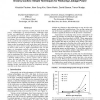Free Online Productivity Tools
i2Speak
i2Symbol
i2OCR
iTex2Img
iWeb2Print
iWeb2Shot
i2Type
iPdf2Split
iPdf2Merge
i2Bopomofo
i2Arabic
i2Style
i2Image
i2PDF
iLatex2Rtf
Sci2ools
ISCA
2002
IEEE
2002
IEEE
Drowsy Caches: Simple Techniques for Reducing Leakage Power
On-chip caches represent a sizable fraction of the total power consumption of microprocessors. Although large caches can significantly improve performance, they have the potential to increase power consumption. As feature sizes shrink, the dominant component of this power loss will be leakage. However, during a fixed period of time the activity in a cache is only centered on a small subset of the lines. This behavior can be exploited to cut the leakage power of large caches by putting the cold cache lines into a state preserving, low-power drowsy mode. Moving lines into and out of drowsy state incurs a slight performance loss. In this paper we investigate policies and circuit techniques for implementing drowsy caches. We show that with simple architectural techniques, about 80%-90% of the cache lines can be maintained in a drowsy state without affecting performance by more than 1%. According to our projections, in a 0.07um CMOS process, drowsy caches will be able to reduce the total e...
Drowsy | Drowsy Caches | Hardware | ISCA 2002 | Large Caches |
| Added | 15 Jul 2010 |
| Updated | 15 Jul 2010 |
| Type | Conference |
| Year | 2002 |
| Where | ISCA |
| Authors | Krisztián Flautner, Nam Sung Kim, Steven M. Martin, David Blaauw, Trevor N. Mudge |
Comments (0)

